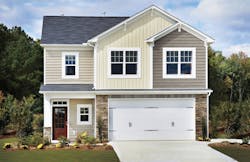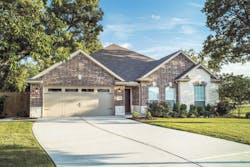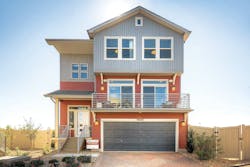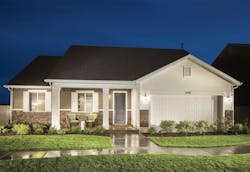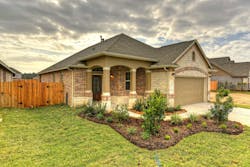Reaching First-Time Buyers With Starter Homes
Earlier this year, economic performance rankings of the 100 biggest U.S. metros were released by The Brookings Institution’s Metropolitan Policy Program. The report was sobering. Between 2009 and 2014, just nine of the 100 largest metro areas exceeded averages in growth, prosperity, and inclusion. Though many parts of the country grew robustly overall during the recovery, median wages declined in 80 of the 100 metro areas studied.
What’s more, “Between 2000 and 2014, median household income declined 3 percent, while median prices for new, single-family homes increased 28 percent over the same period,” says Amy Liu, vice president at Brookings and director of its Metropolitan Policy Program. Shutting middle-class Americans out of homeownership has widespread consequences, translating to less stability for regions, neighborhoods, families, and individuals, she says. Yet a confluence of factors—including student debt, wage stagnation, and strict lending rules—has forced home ownership in the U.S. to its lowest level in half a century.
Factors on the industry side are reducing the number of affordable homes on the market, too. Numbers released by John Burns Real Estate Consulting tell a story of development costs quashing new-home construction. Lot prices, impact and permit fees, labor and material costs, tough regulations, and code changes continue to drive up the cost of building all homes, including those at the entry level. Yet some home builders are responding to the challenge, and they’re succeeding.
For builders equipped to serve the market, the current lack of starter homes for sale is a big opportunity, says Tony Callahan, CEO and president of Callahan Consulting Group. “There are just too many buyers to ignore,” he points out. Those under 35 are now the biggest buyer segment the nation has ever seen. “These are the future pipelines,” says Eric Lipar, chairman and CEO of LGI Homes.
What’s more, the term “entry level” can be deceiving. Often linked to young buyers, it also includes those starting over in the wake of financial turmoil or divorce. “The reason it’s so crucial is that we’re talking about more than first-time buyers. We’re talking about price point,” Callahan says.
Scale, Capital, and DIY Development
Steven Mungo, CEO of Mungo Homes, a builder with a specialty in entry-level homes in Alabama, North Carolina, South Carolina, and Georgia, knows the uphill battles—national and local—that come with building starter homes. “We have incentives and housing policy in place that make it too expensive for the people who put your fires out and teach your children and keep your community safe,” he says. “It doesn’t seem to matter who’s in the White House or the State House; we’re still struggling with effective policy to make sure that people can achieve the American Dream.”
Local pressures factor in, too. “Even when a planning commission wants to do it, there’s pushback from residents,” Callahan says. Mungo observes that most people remain oblivious to the lack of affordable homes for those starting out or starting over until they’re standing face to face with the problem—say, when their kids can’t afford to buy a home.
Builders in the entry-level game often must have sufficient capital to self-develop, something that bank regulators may frown upon. Citing input from his Builder 20 group, Mungo says everyone he talks to mentions improvement costs gone haywire. “There are no merchant developers to buy from anymore, and if no one’s willing to sell you affordable lots, the only alternative is to buy a tract of land, wade through the regulatory process, and develop lots yourself.”
“This is where the housing cycle
starts. Without it, you can’t create
move-up and second move-up buyers.”
– Eric Lipar, Chairman and CEO,
LGI Homes
Velocity, Inventory, and Efficiency
“Entry-level homes is a high-velocity business,” says Eric Lipar, chairman and CEO of LGI Homes, a publicly traded, Houston-based builder that works in eight states. With more than 95 percent of its business in starter homes, LGI averages six closings per community per month and is widely acknowledged as a master of the strategy of starter homes. A builder working in entry-level burns through lots and land at a much brisker pace than at other price points, Lipar says. Often new buyers need to move quickly when the lease on their rental is up, and such short cycle times demand a ready supply of inventory. LGI closed 142 homes last year in Bauer Landing, the builder’s top-selling community, located on the northwest side of Houston.
Entry-level houses “aren’t the ones you’re going to make 12 percent net on,” says Saun Sullivan, owner and CEO of DSLD Homes, which builds in Louisiana, Alabama, Mississippi, and Florida. To appeal to buyers coming from apartments with top-end finishes, value engineering is crucial. “They don’t want to buy a single-family home that’s stripped and ripped,” he says.
Great systems, strict cost control, and a stable trade base are crucial to making entry-level homes profitable, says Pat Hamill, chairman and CEO of Oakwood Homes, which builds in Colorado and Utah. Oakwood delivers more than 100 homes per year in each of its two entry-level communities at Green Valley Ranch, Park House and Carriage House; the company presells from completed models, not inventory. It delivers a home in four months thanks to panelization, which helps with increasing speed, cutting out waste, assuring quality, and producing homes on a consistent and predictable basis. “It’s the future,” Hamill says.
Given the current labor shortage, quick cycle times give builders an edge in getting better pricing from suppliers and availability of contractors, says Mark Tollefsrud, VP of sales and marketing for Legend Classic Homes, in Houston. “If you’ve constantly got action in your neighborhood, subs know they have work in front of them and don’t have to travel. It’s easier to keep crews on site.”
Yet with entry-level homes come vulnerabilities. Mungo has scaled back its ratio of starter homes to about half the business, in an effort to be less exposed to one buyer segment. KB Home cited a similar strategy during its first-quarter earnings call. As reported by Business Insider, CFO Jeff Kaminski noted that KB’s entry-level business has dropped from 60 to 70 percent to about half its business. The publicly traded builder works in nine states.
“You’re going head to head in the marketplace with guys who are really good at this, like D.R. Horton and LGI, which makes it harder to compete,” says Joel Shine, CEO and president of Woodside Homes, which works in Arizona, California, Nevada, and Utah, across several price points.
“You can buy a whole house in most
parts of the country for the price
of a lot in California. That’s a
problem.”– Tony Callahan, president
and CEO, Callahan Consulting Group
Great Expectations?
Though much has been made of Millennial delusions of grandeur, some disagree. “The biggest amenity is the best school district they can afford,” Mungo says. Lipar agrees, insisting that the dominant desires among first-timers are an affordable alternative to renting and more space than the apartment they’re coming from. Shine also finds the chasm between Millennials and other buyers to be exaggerated. “Do they want something different from their parents? Sure, but you’d be surprised by how many Millennials with kids and a dog want good schools, a backyard, and a traditional suburban home,” Shine says. He acknowledges that although the home may look different from what they grew up in—an open plan with no formal dining room—“Millennials, as they get older, look an awful lot more like prior generations than people want to admit.”
Not all builders concur.
Density and a Sense of Community
Hamill, of Oakwood Homes, sees a difference in today’s first-timers. Oakwood’s average buyer is age 34—a decade older than the 25- and 26-year-olds he used to sell to. The new first-timers are more mature, have experience living on their own—often in the city—and, Hamill says, want “amenities, choice, bells and whistles.” With the slogan, “Luxury at every level,” Oakwood makes a play for that cohort. Hamill notes that buyers coming from city neighborhoods want a similar sense of community in the place they’re moving to. “They’re OK with smaller yards,” he says, “and building at nine units to the acre has helped us make the price more affordable.” Density appeals to these buyers.
Hamill says that a key to Oakwood’s success with first-timers in MPCs is “being able to put them in a neighborhood that has parks, recreation, trails, communal gardens, and a beer garden,” referring to Green Valley Ranch. “As long as you can deliver the community feel and amenities they want, it’s very doable,” he says.
Legend Classic Homes, a Houston builder, addresses concerns about a sense of place by “panel building,” in which construction of new homes begins at one end of a street and progresses lot by lot, leaving no empty spaces. While some builders prefer to start at the back and move forward, Legend starts at the front. “As a street scene starts to develop, it gives more of a comfort factor about moving forward,” explains Mark Tollefsrud, VP of sales and marketing.
Historically, entry-level product has been built in drive-’til-you-qualify locations. But buyers are shying away from ‘C’ and ‘D’ locations, Sullivan says. “They want to be near amenities and not in the car all the time.”
Sustainability–Ecological and Economic
“This buyer is green, green, green,” says Hamill, noting that first-time buyers care about a builder’s attention to energy efficiency, recycling, use of eco-friendly products, and minimizing waste. Oakwood includes solar pre-wiring in every home in its Carriage House starter-home community. Energy efficiency isn’t just a feel-good issue for first-timers. “It produces a lower cost of ownership, allowing you to enjoy the features you wouldn’t have gotten otherwise,” says Larry Oglesby, senior VP of operations for KB Home. In Mungo’s smaller-footprint homes, the power bill is “no higher than the apartment that they moved out of, where a neighbor was buffering,” Steven Mungo says. The builder’s hauSmart program involves HERS-rating every home sold.
As the issue of water takes on increasing urgency, some builders are including water conservation features in starter product. All homes that KB Home sells are Energy Star-certified and have WaterSense features; the builder also offers entry-level homes in several of its WaterSense communities. In its Camellia starter home community, Legend Classic Homes turned a bioswale into a water garden with visual appeal. Landscaping a stormwater management necessity created a lush piece of property that’s easier on the eyes than looking at hardscape or the house across the street.
Delay Has a Silver Lining
Though the delay of young buyers in settling down and starting families has stalled sales, it may also offer upsides. “Very first-time buyers are more savvy,” says Oglesby, citing higher incomes, greater maturity, and readiness to meet strict lending standards. “They’re older and making more money, but they have a fair amount of college debt, so getting anybody financed is becoming more difficult,” Hamill says. But overall, he notices a more responsible and accountable buyer. “They saw what happened to their parents and friends in the great recession, and it has made them very cautious.”
In light of rising costs and affordability challenges, Liu wonders if delivering homes within middle-class reach might not require a shift in mindset. “The average American consumer is not better off today,” she says. At issue is economic strength, progress, and resilience. Builders have a responsibility to offer homes accessible to the majority of households, she adds. “This would be a win-win for families and industries.”
The Art of the Start: Advice on Entry Level
Pat Hamill, Chairman and CEO, Oakwood Homes
2015 HOUSING GIANTS RANKING: 42 (51 in 2014)
You have to have a margin that allows you to be sustainable and then be able to replicate it.
Eric Lipar, Chairman and CEO, LGI Homes
2015 HOUSING GIANTS RANKING: 25 (35 in 2014)
Offer limited floor plans and options, and keep it as simple as possible.
Steven Mungo, CEO, Mungo Homes
2015 HOUSING GIANTS RANKING: : 53 (59 in 2014)
You need to be able to deliver lots effectively and take down larger tracts of land.
Larry Oglesby, Senior VP of National Operations, KB Home
2015 HOUSING GIANTS RANKING: 8 (8 in 2014)
Understand what’s trending for the customer and be precise about your location.
Joel Shine, CEO and president, Woodside Homes
2015 HOUSING GIANTS RANKING: 28 (32 in 2014)
Spend time mastering the art of whatever market you get into. Decide on how you want to go about it, stick to your knitting, and go do it.
Saun Sullivan, Owner and CEO, DSLD Homes
2015 HOUSING GIANTS RANKING: 36 (40 in 2014)
Speak clearly to first-time buyers about what they consider necessities and what they’re willing to trade off. Make sure they understand the financing so they stay qualified throughout the process.
Mark Tollefsrud, Vice President Sales and Marketing, Legend Classic Homes
2015 HOUSING GIANTS RANKING: 84 (55 in 2014)
The cost of your product and what you’re putting into it is key. Don’t get carried away with upgrades.


